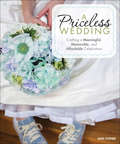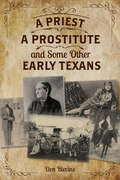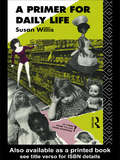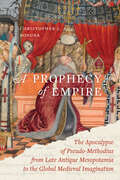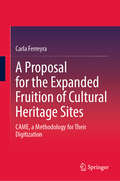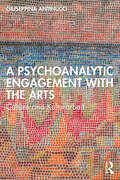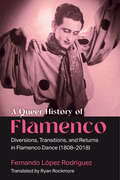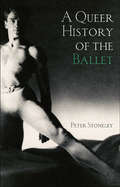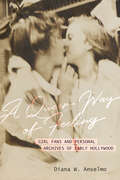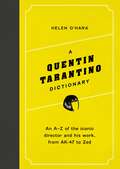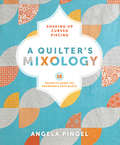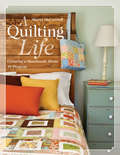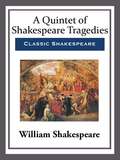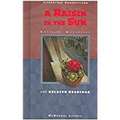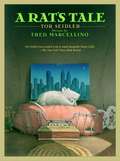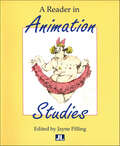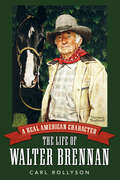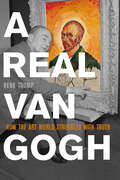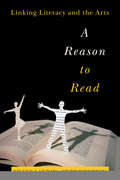- Table View
- List View
A Priceless Wedding: Crafting a Meaningful, Memorable, and Affordable Celebration
by Sara CotnerPlan a wedding that reflects your commitment—to each other and to the things you truly value.How you and your partner plan your wedding can set a precedent for how you will be as a family. How do you work together to merge two different sets of ideas into something bigger and better? How do you disagree in constructive rather than destructive ways? How do you honor the input and experience of family members while simultaneously maintaining ownership of your lives and choices? In this part-memoir, part how-to handbook, popular wedding blogger Sara Cotner shares how you can resist the pressure to create the wedding of someone else's dreams and instead reclaim the real purposes of a wedding: community, connection, commitment, and fun. A Priceless Wedding covers all the basics: securing a location, finding a dress, deciding on flowers, selecting a wedding party, planning the ceremony, choosing rings, and everything in between—but it goes beyond the elements of a "traditional" wedding to help you plan an eco-friendly, hand-crafted, budget-minded celebration that will be both memorable and meaningful. Featuring do-it-yourself projects that help you create your own unique wedding favors, sew a homemade wedding quilt, and more, this book will inspire you to begin your own traditions and rituals that will clarify your values and let you live them out loud.
A Priest, A Prostitute, and Some Other Early Texans: The Lives Of Fourteen Lone Star State Pioneers
by Don BlevinsThis unique collection of short biographies of the Lone Star State&’s most colorful characters includes headliners Father Miguel Muldoon, the Irish-Spanish Catholic priest and diplomat who helped convert Protestants in order to settle Austin, and six-foot-two prostitute and hotelkeeper Sarah Bowman, who fought as bravely as a man among the Rangers and was buried with full military honors. These are just two of the pioneers who helped build the state amidst wars with Seminoles and Mexicans, gold rushes, and cavalry formations. These fourteen vivid accounts of extraordinary lives are like no other history of Texas and will reach a wide audience of readers who love to read about real people.
A Primer For Daily Life (Studies in Culture and Communication)
by Susan WillisFirst published in 1991. Routledge is an imprint of Taylor & Francis, an informa company.
A Primer on Theory in Architecture
by Karen Cordes SpenceA Primer on Theory in Architecture discusses how theory is defined in architecture, how it is identified, its location in larger perspectives or worldviews, its relationships to other areas in architecture, and how it can be constructed. The book explores the definition, elements and characteristics of theory along with subjects associated with theory and how these associations are recognized. In addition, case studies tackle both individual theorists and common approaches to the topic. Aimed at the new student of architectural theory, if you are just beginning to tackle this subject, begin with this book.
A Printed Icon in Early Modern Italy
by Lisa PonIn 1428, a devastating fire destroyed a schoolhouse in the northern Italian city of Forlì, leaving only a woodcut of the Madonna and Child that had been tacked to the classroom wall. The people of Forlì carried that print - now known as the Madonna of the Fire - into their cathedral, where two centuries later a new chapel was built to enshrine it. In this book, Lisa Pon considers a cascade of moments in the Madonna of the Fire's cultural biography: when ink was impressed onto paper at a now-unknown date; when that sheet was recognized by Forlì's people as miraculous; when it was enshrined in various tabernacles and chapels in the cathedral; when it or one of its copies was - and still is - carried in procession. In doing so, Pon offers an experiment in art historical inquiry that spans more than three centuries of making, remaking, and renewal.
A Prophecy of Empire: The Apocalypse of Pseudo-Methodius from Late Antique Mesopotamia to the Global Medieval Imagination (Christianity in Late Antiquity)
by Christopher J. BonuraThe Apocalypse of Pseudo-Methodius was one of the medieval world’s most popular and widely translated texts. Composed in Syriac in Mesopotamia in the seventh century, this supposed revelation presented a new, salvific role for the Roman Empire, whose last emperor, it prophesied, would help bring about the end of the ages. In this first book-length study of Pseudo-Methodius, Christopher J. Bonura uncovers the under-appreciated Syriac origins of this apocalyptic tract, revealing it as a remarkable response to political realities faced by Christians living under a new Islamic regime. Tracing the spread of Pseudo-Methodius from the early medieval Mediterranean to its dissemination via the printing presses of early modern Europe, Bonura then demonstrates how different cultures used this new vision of empire’s role in the end times to reconfigure their own realities. The book also features a new, complete, and annotated English translation of the Syriac text of Pseudo-Methodius.
A Proposal for the Expanded Fruition of Cultural Heritage Sites: CAME, a Methodology for Their Digitization
by Carla FerreyraThis book presents a comprehensive methodology, integrating analysis, digitization, and the preservation of cultural heritage. It investigates three potential UNESCO World Heritage Sites, in Italy, Germany and South Africa, and employs a blend of documentary research and advanced digital surveying and data processing techniques. The volume shows how these efforts yielded actionable strategies to meet society's evolving demands for surveying, recovery, and conservation. The book documents the work behind the overarching objective which was to digitize, analyze, categorize, and store all collected data within a BIM framework, with the aim of streamlining collaboration, enhancing management efficiency, and optimizing processes. It demonstrates the utilization of digital tools in not only amplifying traditional scientific-technological approaches to heritage protection, but also its role in reshaping the perception, comprehension, and communication of heritage. This fosters the development of more sustainable conservation strategies.
A Psychoanalytic Engagement with the Arts: Culture and Kulturarbeit
by Giuseppina AntinucciA Psychoanalytic Engagement with the Arts applies Freud’s anthropological writing and theories to contemporary works of fiction and poetry.Giuseppina Antinucci offers close readings of the works of contemporary literary figures Chimamanda Ngozi Adichie, Amelia Rosselli and Jhuma Lahiri, from a psychoanalytic standpoint. Through these close readings, Antinucci uses the interweaving of the characters’ psychology with the demand of their social context to interrogate the factors that impact on their capacity and condition for survival. Throughout, she applies the Freudian concept of Kulturarbeit - the quota of psychic work pertaining to the symbolic order - and considers contemporary human experiences of migration and border-crossing, reparation, trauma and critical race theory from a psychoanalytic perspective. Adopting Winnicottian, Lacanian and Freudian methodologies, Antinucci adeptly illustrates the impact of psychoanalysis on art and vice versa, offering a novel way to approach contemporary issues of the psyche and human experience. Using a psychoanalytic engagement of contemporary fiction to address the complexity of human existence, this volume will be of interest to psychoanalysts, as well as researchers and students interested in the intersection between psychoanalysis and the creative arts.
A Queer History of Flamenco: Diversions, Transitions, and Returns in Flamenco Dance (1808–2018)
by Fernando López RodríguezA Queer History of Flamenco offers a groundbreaking exploration of flamenco through the lenses of queer theory and cultural studies. Previous histories have provided a largely distorted image about why, where, and how people have done flamenco—as well as who has performed flamenco. Yet feminists, transvestites, butches, femmes, the Spanish Roma, disabled people, guiris, and “incomprehensible” artists have been determined to do things differently without giving up their flamenco status. In this skillful translation of his book Historia queer del flamenco, Fernando López Rodríguez draws on diverse archival materials as well as his own lived experience and artistic practice, unearthing queer flamenco histories, voices, and perspectives that were previously unknown, avoided, or purposely hidden. Tracing flamenco’s development from its birth up to the contemporary era, the book places flamenco within significant historical periods such as the Spanish Civil War, Franco’s dictatorship, the transition to democracy, and the economic crisis of 2008, up to contemporary performances of the late 2010s. In taking a queer approach to History, the author abandons antiquated debates about purities and impurities; anecdotes about the lives of artists that are completely detached from their processes of creation; and myths about geniuses who seem to make art alone and completely detached from their collaborators and the historical, social, economic and artistic moment in which they lived. A Queer History of Flamenco is not only about the present and the queerness of people living, performing, or creating in it, but also about flamenco’s past in which so many queer artists and practices and their lives have remained unearthed and unaddressed.
A Queer History of the Ballet
by Peter StoneleyDesigned for students, scholars and general readers with an interest in dance and queer history, A Queer History of the Ballet focuses on how, as makers and as audiences, queer men and women have helped to develop many of the texts, images, and legends of ballet. Presenting a series of historical case studies, the book explores the ways in which, from the nineteenth century into the twentieth, ballet has been a means of conjuring homosexuality – of enabling some degree of expression and visibility for people who were otherwise declared illegal and obscene. Studies include: the perverse sororities of the Romantic ballet the fairy in folklore, literature, and ballet Tchaikovsky and the making of Swan Lake Diaghilev’s Ballets Russes and the emergence of queer modernity the formation of ballet in America the queer uses of the prima ballerina Genet’s writings for and about ballet. Also including a consideration of how ballet’s queer tradition has been memorialized by such contemporary dance-makers as Neumeier, Bausch, Bourne, and Preljocaj, this is an essential book in the study of ballet and queer history.
A Queer Way of Feeling: Girl Fans and Personal Archives of Early Hollywood (Feminist Media Histories #4)
by Diana W. AnselmoA Queer Way of Feeling gathers an unexplored archive of fan-made scrapbooks, letters, diaries, and photographs to explore how girls coming of age in the United States in the 1910s used cinema to forge a foundational language of female nonconformity, intimacy, and kinship. Pasting cross-dressed photos into personal scrapbooks and making love to movie actresses in epistolary writing, girl fans from all walks of life stitched together established homoerotic conventions with an emergent syntax of film stardom to make sense of feeling "queer" or "different from the norm." These material testimonies show how a forgotten audience engendered terminologies, communities, and creative practices that became cornerstones of media fan reception and queer belonging.
A Quentin Tarantino Dictionary: An A–Z of the iconic director and his work, from AK-47 to Zed (Director Dictionaries)
by Helen O'HaraExplore an A-Z of everything you need to know about the masterful movies of Quentin Tarantino, from AK-47 to "Zed's dead, baby" and everything in between.With hundreds of entries covering every facet of Tarantino's work - from inspiration and influences to his most frequent collaborators and little-known cameos - A Quentin Tarantino Dictionary is a stylish guide to the wonderful world of this visionary filmmaker.Written by author and film critic Helen O'Hara (Empire, BAFTA, the Telegraph) and with bespoke illustrations that bring the director's vision to life, this is a one-stop shop for all things Tarantino.
A Quentin Tarantino Dictionary: An A–Z of the iconic director and his work, from AK-47 to Zed (Director Dictionaries)
by Helen O'HaraExplore an A-Z of everything you need to know about the masterful movies of Quentin Tarantino, from AK-47 to "Zed's dead, baby" and everything in between.With hundreds of entries covering every facet of Tarantino's work - from inspiration and influences to his most frequent collaborators and little-known cameos - A Quentin Tarantino Dictionary is a stylish guide to the wonderful world of this visionary filmmaker.Written by author and film critic Helen O'Hara (Empire, BAFTA, the Telegraph) and with bespoke illustrations that bring the director's vision to life, this is a one-stop shop for all things Tarantino.
A Question of Sport Quiz Book
by David Gymer and David BallAfter more than four decades on the air, A Question of Sport is firmly established as the final word in sports trivia. Now, after countless arguments, sporting debates and lost hours spent directing the action from the sofa, you can finally test your own knowledge to see if you can succeed where so many sporting greats have failed.With over 3,500 brand new questions, A Question of Sport Quiz Book will challenge you to put your money where your mouth is and put your knowledge of the sports world to the ultimate test. Play on your own or in teams to answer questions covering all eras of football, golf, cricket, motor racing, boxing, rugby, darts, snooker, the Olympics and so much more.With questions from your favourite rounds from A Question of Sport, here at last is your chance to take on the captain's challenge, or go head-to-head on the quick-fire buzzer round. What will be your score when the final whistle blows?
A Quilter's Mixology: Shaking Up Curved Piecing
by Angela PingelFollow the "Drunkard's Path" to curved piecing! You'll discover an introduction to curved piecing via one simple block--Drunkard's Path. Author Angela Pingel demonstrates how this single block can be put together in various patterns that look absolutely different in every combination. Drunkard's Path can create a sinuous staggering line like its namesake or curved motifs that form teardrops, arabesques, flowers, and other discrete shapes. Dive deep into the basics of curved piecing and then explore a variety of projects including full-size quilts, baby quilts, pillows, and a table runner. Find inspiring new ways to use that old favorite, Drunkard's Path block, to create quilts that look new and different. A Quilter's Mixology is the perfect "next-step" book geared towards intermediate quilters or quilters looking for the next challenge.
A Quilting Life: Creating a Handmade Home
by Sherri McConnell“With its diverse selection of fabrics and designs, A Quilting Life is a fine pick for any quilter looking to produce family-oriented keepsake results.” —The Needlecraft ShelfBring the handmade tradition home with these charming quilts and home accessories. Inspired by a grandmother who loved to sew for her family, quilter and blogger Sherri McConnell gives traditional patterns like hexagons, stars, snowballs, and Dresden Plates a new look featuring fabrics by some of today’s most popular designers. Nineteen cozy projects include pillows, tote bags, table runners, and larger quilts—quick and easy designs that make great gifts.“Sherri’s book is a treasure! It’s full of fun and straight-forward patterns for quilts, table toppers, pillows, bags and more—all the goodies to make a cozy home.” —Thimbleanna“Would you like the opportunity to make tomorrow’s heirlooms in today’s vast selection of prints? . . . If so, this could be the reference book that will get you started. There are 19 projects, mainly focusing on handmade household items but including some larger quilts too.” —Fabrications Quilting for You“Beautiful inspiration if you are a seasoned quilter, but also a great resource with clear and in some cases, simple patterns for newbies as well.” —Diary of a Quilter“Color photos of finished needlework projects accompany step-by-step diagrams and assembly patterns, while at-a-glance sidebars covering materials and cutting allow needleworkers to gauge the complexity of each project.” —The Needlecraft Shelf
A Quintet of Shakespeare Tragedies
by William ShakespeareMurder, Mayhem, and Madness-- Collected here are five of William Shakespeare's greatest tragedies Romeo and Juliet, Hamlet, Macbeth, Othello, and King Lear. These are the plays that made Shakespeare's reputation. Murder, deceit, treachery, and madness play out on the grand stage. Stories for the ages! Tomorrow, and tomorrow, and tomorrow Creeps in this petty pace from day to day To the last syllable of recorded time; And all our yesterdays have lighted fools The way to dusty death. Out, out, brief candle! Life's but a walking shadow, a poor player That struts and frets his hour upon the stage And then is heard no more. It is a tale Told by an idiot, full of sound and fury, Signifying nothing.
A Rainbow in Brown
by Pavonis GironJo wants to paint all the wonderful things she loves. With a palette of red, yellow, and blue, Jo knows she can mix any colors together to create new ones. Her imagination takes flight as she explores painting with primary and by mixing her own secondary colors, each picture as beautiful as the last. But through her exploration of the colors of the rainbow, Jo finds that her favorite is a combination of them all: brown. <p> With stunning artistry from debut author/illustrator Pavonis Giron comes an illuminating story of self-love through color theory.
A Raisin In The Sun (Mcdougal Littell Literature Connections)
by McDougal-Littell Publishing StaffThe author writes of her childhood experiences with racism.
A Rat's Tale
by Tor SeidlerAlthough young Montague Mad-Rat lives in, or rather, under, New York City, he knows very few rats besides his mother, who makes hats, his father, who builds mud castles, and his globe-trotting Aunt Elizabeth. But Montague's life takes an abrupt turn on the eventful stormy day he meets Isabel Moberly-Rat on his way home from Central Park. Home, for Montague, is an old sewer pipe. He now learns that there is a city full of other rats out there who inhabit abandoned piers and lead considerably less eccentric and more luxurious lives than his family.
A Reader in Animation Studies
by Jayne PillingCartoons—both from the classic Hollywood era and from more contemporary feature films and television series—offer a rich field for detailed investigation and analysis. Contributors draw on theories and methodology from film, television, and media studies, art history and criticism, and feminism and gender studies.
A Reader on International Media Piracy: Pirate Essays (MediaMatters)
by Tilman BaumgärtelPiracy is among the most prevalent and vexing issues of the digital age. In just the past decade, it has altered the music industry beyond recognition, changed the way people watch television, and made a dent in the buisness of the film and software industries. From MP3 files to recipes from French celebrity chefs to the jokes of American stand-up comedians, piracy is ubiquitous. And now piracy can even be an arbiter of taste, as seen in the decision by Netflix Netherlands to license heavily pirated shows., In this unflinching analysis of piracy on the Internet and in the markets of the Global South, Tilman Baumgärtel brings together a collection of essays examining the economic, political, and cultural consequences of piracy. The contributors explore a wide array of topics, which include materiality and piracy in Rio de Janeiro; informal media distribution and the film experience in Hanoi, Vietnam; the infrastructure of piracy in Nigeria; the political economy of copy protection; and much more. Offering a theoretical background for future studies of piracy, A Reader in International Media Piracy is an important collection on the burning issue of the Internet Age. This timely collection featuring both empirical and theoretical essays brings together the latest reflections on piracy and its economic, political, cultural and theoretical consequences.
A Real American Character: The Life of Walter Brennan (Hollywood Legends Series)
by Carl RollysonWalter Brennan (1894-1974) was one of the greatest character actors in Hollywood history. He won three Academy Awards and became a national icon starring as Grandpa in The Real McCoys. He appeared in over two hundred motion pictures and became the subject of a Norman Rockwell painting, which celebrated the actor's unique role as the voice of the American Western. His life journey from Swampscott, Massachusetts, to Hollywood, to a twelve thousand-acre cattle ranch in Joseph, Oregon, is one of the great American stories. In the first biography of this epic figure, Carl Rollyson reveals Brennan's consummate mastery of virtually every kind of role while playing against and often stealing scenes from such stars as Gary Cooper, Humphrey Bogart, and John Wayne. Rollyson fully explores Brennan's work with Hollywood's greatest directors, such as Howard Hawks, John Ford, and Fritz Lang. As a father and grandfather, Brennan instilled generations of his family with an outlook on the American Dream that remains a sustaining feature of their lives today. His conservative politics, which grew out of his New England upbringing and his devout Catholicism, receive meticulous attention and a balanced assessment in A Real American Character. Written with the full cooperation of the Brennan family and drawing on material in archives from every region of the United States, this new biography presents an artist and family man who lived and breathed an American idealism that made him the Real McCoy.
A Real Van Gogh: How the Art World Struggles with Truth
by Henk TrompVincent van Gogh’s paintings and drawings are fabulously expensive. Millions of people admire his work, but are those masterpieces all genuine? To this day, the international art world struggles to separate the real Van Goghs from the fake ones, and the key question addressed in this book is what may happen to art experts when they publicly voice their opinions on a particular Van Gogh (or not). The story starts with art expert J.B. de la Faille who discovered to his own bewilderment that he had included dozens of fake Van Goghs in his 1928 catalogue raisonné. He wanted to set the record straight, but met with strong resistance from art dealers, collectors, critics, politicians and others, marking the beginning of a fierce clash of interests that had seized the art world for many decades of the twentieth century. In his fascinating account of the struggle for the genuine Vincent van Gogh, Tromp shows the less attractive side of the art world. His reconstruction of many such confrontations yields a host of intriguing and sometimes bewildering insights into the fates of art experts when they bring unwelcome news. A Real Van Gogh shows how much resistance an art expert might meet when he discovers a fake Van Gogh.
A Reason to Read: Linking Literacy and the Arts
by Eileen Landay Kurt WoottonA Reason to Read is the culminating work of the ArtsLiteracy Project, an ambitious and wide-ranging collaborative that aims to promote literacy through rich and sustained instruction in the arts. At the heart of the book is the &“Performance Cycle,&” a flexible framework for curriculum and lesson planning that can be adapted to all content areas and age groups. Each of the book&’s main chapters delineates and explores a particular component of the cycle. A practical, readable, and inspiring book, A Reason to Read will be of immeasurable help to school teachers, education leaders, and all who have a stake in promoting literacy and the arts in today&’s schools.
